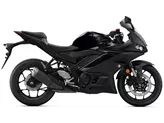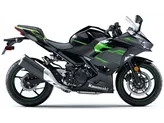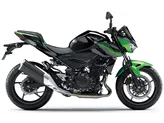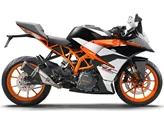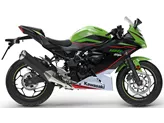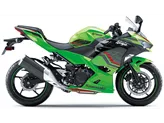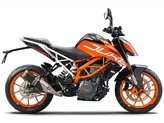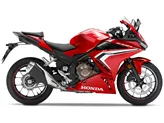Kawasaki Ninja 400 2018 vs. Kawasaki Z 300 2015

Kawasaki Ninja 400 2018

Kawasaki Z 300 2015
Overview - Kawasaki Ninja 400 2018 vs Kawasaki Z 300 2015
The Kawasaki Ninja 400 2018 and the Kawasaki Z 300 2015 are both impressive motorcycles with their own unique features and strengths.
Starting with the technical specifications, both models have an in-line engine type, but the Ninja 400 has a larger bore of 70 mm compared to the Z 300's 62 mm. The stroke of the Ninja 400 is also longer at 51.8 mm, while the Z 300 has a stroke of 49 mm. In terms of engine power, the Ninja 400 comes out on top with 45 HP, while the Z 300 has 39 HP. The Ninja 400 also has a higher torque of 38 Nm compared to the Z 300's 27 Nm. The compression ratio of the Ninja 400 is 11.5, while the Z 300 has a compression ratio of 10.6. Both models have 2 cylinders and 4 valves per cylinder, as well as liquid cooling. However, the Ninja 400 has a larger displacement of 399 ccm, while the Z 300 has a displacement of 296 ccm.
Moving on to the chassis, both models have a steel frame. The Ninja 400 has a double piston front brake with petal technology, while the Z 300 also has a double piston front brake with petal technology.

Kawasaki Ninja 400 2018
In terms of dimensions and weights, both models have a front tire width of 110 mm and a front tire diameter of 17 inches. The Ninja 400 has a rear tire width of 150 mm and a rear tire diameter of 17 inches, while the Z 300 has a rear tire width of 140 mm and a rear tire diameter of 17 inches. The Ninja 400 has a wheelbase of 1370 mm, while the Z 300 has a slightly longer wheelbase of 1405 mm. Both models have a seat height of 785 mm. The Ninja 400 has a kerb weight (with ABS) of 168 kg, while the Z 300 has a slightly heavier kerb weight (with ABS) of 170 kg. The Z 300 also has a larger fuel tank capacity of 17 liters, compared to the Ninja 400's 14 liters.
Now let's discuss the strengths and weaknesses of each model. The Ninja 400 has a chassis suitable for sporty use, making it ideal for those who enjoy a more aggressive riding style. Its low weight and effortless handling make it easy to maneuver, while the engine provides a smooth response. The relaxed and confidence-enhancing seating position adds to the overall comfort of the bike. Additionally, the Ninja 400 features LED headlights, which improve visibility and safety.

Kawasaki Z 300 2015
On the other hand, the Z 300 has a more adult look and boasts a high-quality finish. Its high-revving engine delivers a thrilling riding experience, and the comfortable seating position makes long rides more enjoyable. The stable brake provides reliable stopping power, and the easy-to-read, complete cockpit ensures that all necessary information is readily available. Furthermore, the Z 300 has a low fuel consumption, making it a cost-effective option for riders.
However, both models have their weaknesses. The Ninja 400's brake and clutch levers are not adjustable, which may be a drawback for some riders. Additionally, riders over 180cm tall may experience an enormously loud wind noise with the original windshield. On the other hand, the Z 300 has a very unobtrusive sound, which may not appeal to those seeking a more aggressive exhaust note. The engine of the Z 300 only starts when idling, which may be inconvenient for some riders.
In conclusion, both the Kawasaki Ninja 400 2018 and the Kawasaki Z 300 2015 are excellent motorcycles with their own unique strengths and weaknesses. The Ninja 400 offers a sportier riding experience with its powerful engine and agile handling, while the Z 300 provides a more comfortable and fuel-efficient option. Ultimately, the choice between the two models will depend on the rider's preferences and intended use of the motorcycle.
Technical Specifications Kawasaki Ninja 400 2018 compared to Kawasaki Z 300 2015
Pros and Cons in comparison
Pros and Cons in comparison
Kawasaki Ninja 400 2018

Ninja 400, süperspor dünyasina mükemmel bir giris olarak özetlenebilir. A2 ile daha fazla güç mümkün degil, görünüsü çok daha fazla gücü çagristiriyor, aracin kullanimi kolay, her açidan affedici ve yine de gerçekten sportif bir sürüs tarzina izin veriyor. Çesitli 250 metreküp makinelerde güç eksikligi konusunda hakli endiseleri olan herkesin artik bahanesi kalmadi. Ninja 400, iyi ki buradasin!
Kawasaki Z 300 2015

Kawasaki Z300, sadece ablasi Z800'e son derece benzeyen havali tasarimi nedeniyle bile çok olgun görünümlü bir motosiklettir. Dengeli fren sistemi ve analog devir sayaci ve gerekli tüm özelliklere sahip okunmasi kolay kokpit bu görüntüye çok iyi uyuyor. Yol tutus açisindan, sadece 170 kiloluk sürüse hazir agirligi sayesinde son derece manevra kabiliyetli ve eglencelidir. Motor sadece üst devir araliginda potansiyelini ortaya koyuyor, ancak istekli bir sekilde devirleniyor ve sportif bir sürüs tarzi sagliyor. Sadece konfor odakli sasi, radikal sportif taleplerle tam olarak basa çikamiyor - ancak bu, giris seviyesi bir motosiklet için tamamen mesru ve anlasilabilir bir durum.
Price Comparison Avarage Market Price Kawasaki Ninja 400 vs Kawasaki Z 300
There are a few key differences between a Kawasaki Ninja 400 2018 and a Kawasaki Z 300 2015. There are the same number of bikes of both models available on the 1000PS.de marketplace, specifically 10. It takes less time to sell a Kawasaki Ninja 400 with 105 days compared to 111 days for a Kawasaki Z 300. Since model year 2018 1000PS.de editors have written 9 reviews for the Kawasaki Ninja 400 and 5 reviews for the Kawasaki Z 300 since model year 2015. The first review for the Kawasaki Ninja 400 was published on 11/22/2017 and now has more than 44,300 views. This compares to more than 59,800 views for the first review on Kawasaki Z 300 published on 11/4/2014.


